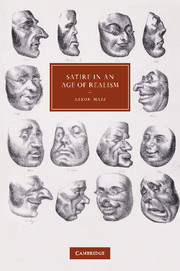Book contents
- Frontmatter
- Contents
- Preface
- Acknowledgments
- 1 Augustan satire and Victorian realism
- 2 Terminal satire and Jude the Obscure
- 3 George Gissing's ambivalent realism
- 4 The English critics and the Norwegian satirist
- 5 Truth and caricature in The Secret Agent
- Epilogue
- Notes
- Bibliography
- Index
- CAMBRIDGE STUDIES IN NINETEENTH-CENTURY LITERATURE AND CULTURE
5 - Truth and caricature in The Secret Agent
Published online by Cambridge University Press: 04 April 2011
- Frontmatter
- Contents
- Preface
- Acknowledgments
- 1 Augustan satire and Victorian realism
- 2 Terminal satire and Jude the Obscure
- 3 George Gissing's ambivalent realism
- 4 The English critics and the Norwegian satirist
- 5 Truth and caricature in The Secret Agent
- Epilogue
- Notes
- Bibliography
- Index
- CAMBRIDGE STUDIES IN NINETEENTH-CENTURY LITERATURE AND CULTURE
Summary
A NEW DEPARTURE IN GENRE
Joseph Conrad completed The Secret Agent in 1906, but it was not until the following year that he first turned to crafting the title page and dedication to H.G. Wells. In June 1907 he wrote to his agent, J.B. Pinker: “I am thinking of dedicating the vol to Wells. I hinted something of that to him already. The full title I wish to run like this: “THE/ SECRET AGENT/ A Simple Tale.” By the following month, when Conrad wrote directly to Wells to announce the dedication formally, the novel's subtitle had expanded: “To/ H.G. Wells/ The Chronicler of Mr Lewisham's Love/ The Biographer of Kipps and/ The Historian of the Ages to Come/ This Simple tale of the XIX Century/ is affectionately inscribed.”
Why did Conrad's “Simple Tale” become a “Simple tale of the Nineteenth Century”? The modest caption was suspicious enough on its own; now it was paired, almost paradoxically, with a rather grandiose declaration that Conrad's new novel had something consequential to say about the century just concluded. The most obvious explanation for Conrad's phrase is the book's chronology: based on the notorious Greenwich Park bomb outrage of 1894, The Secret Agent takes place in that same era, in 1887. It is a book that pivots on the fin de siècle: written just after the century's turn, set just before it.
- Type
- Chapter
- Information
- Satire in an Age of Realism , pp. 142 - 172Publisher: Cambridge University PressPrint publication year: 2010

